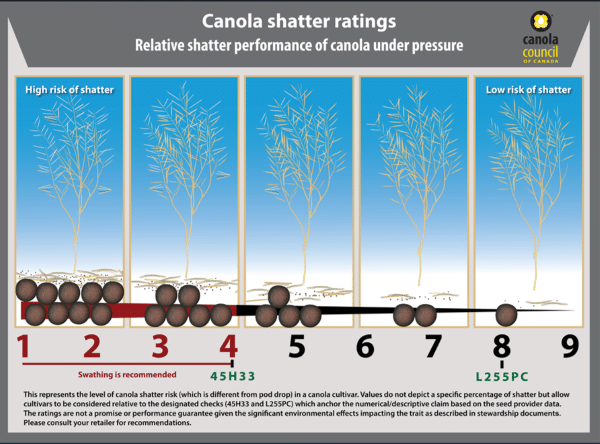How to manage canola at harvest for safer storage?
Safe canola seed storage is top of mind as harvest is well underway. Though daytime ambient temperatures have cooled, some canola may enter the bin unsafely hot. This is one of several key storage risks, as are weed seeds and green material. Even a relatively small patch of combined kochia, if those seeds have higher moisture than canola grain, can create a hot spot in the bin. In straight cut canola not treated with a harvest aid, pods and seeds may be adequately dry but green stems may contribute high-moisture dockage to the sample. Follow these conditioning tips, even for relatively cool and dry grain. Also plan for how best to store and sell harvested seed from fields with variable maturity, which poses greater storage risk. Always take representative samples from all bins at harvest. (Green seed common questions)
What to keep in mind for fall weed control?
Fall is a good time for weed control, both for soil moisture conservation going into spring and because winter annuals are small and easier to manage. Carefully select herbicide products based on the current date and next year’s cropping plans. This table can help.
Rain after harvest may promote canola regrowth. While regrowing canola can be used as a cover crop to manage erosion and sequester carbon, it will take up valuable nutrients and moisture. If herbicide control is the preferred management option, keep in mind that regrowth’s mature root system and small above-ground biomass will hamper chemical control. Use a higher rate of glyphosate and a tank mix partner. Glyphosate will take two to three weeks for visible above-ground symptoms in regrowing canola and/or weeds, especially in fall when growth slows. (Fall weed control timing and targets)
How to choose the right cultivars for next year?
Selecting cultivars based on the unique challenges and opportunities of each particular field increases a canola field’s potential productivity and profitability. Scout for current disease issues, conduct plant counts and review yield (if yield data is available already) to assess which hybrids performed best this year. Then, consider options including available seed treatments for next year: this article provides in-depth information on recommended options for various disease and management priorities.
How to tell verticillium stripe from blackleg?
Using the ‘Is it verticillium stripe or blackleg?’ field guide and the CCC disease scouting guide, scout before and after swathing/harvest for all end-of-season diseases, including verticillium stripe, sclerotinia, blackleg and clubroot. Verticillium stripe is being reported widely this year, not surprising given that it is one of the few diseases that can be more severe in dry conditions. Verticillium stripe is regularly confused with blackleg but can be differentiated via several key visual differences:
- Smaller ‘specks’: As verticillium stripe infection progresses, the epidermis should peel away from weakened stems to reveal tiny specks – microsclerotia – beneath. These specks are similar to but much smaller than blackleg pycnidia.
- More spread-out discolouration: Like blackleg, verticillium stripe causes a darkening of the stem cross-section. However, while blackleg causes distinct black wedge shapes, verticillium stripe discolouration is spread throughout the cross-section and gets continually darker as microsclerotia build up.
- Larger portion of the stem impacted: discolouration from verticillium stripe can extend from below ground level up the stem, whereas blackleg is concentrated in the crown around ground level.
No fungicide option is available for verticillium stripe, but rotation can help. (Verticillium stripe identification and management) (Video: verticillium stripe lifecycle and disease severity)
How often to check for harvest losses?
Harvest losses can vary widely based on cutting type (straight versus swathed), time of day, field conditions, shatter ratings and more. Losses can be five bu./ac., biting into profit and contributing to the weed seedbank. The first step to mitigate loss is knowing what’s being left in the field. Because electronic loss monitors do not accurately measure losses behind the combine, a drop-pan check should be conducted regularly: at least every time there is a difference in the crop and/or environmental conditions and anytime settings on the combine are changed. Here are easy to follow instructions for conducting a drop-pan check and for calculating loss per acre. The CCC’s Canola Calculator includes a harvest loss calculator to determine combine seed losses and a combine optimization tool to help troubleshoot issues with grain loss, grain sample quality and productivity and suggests setting adjustments to improve canola harvest.

